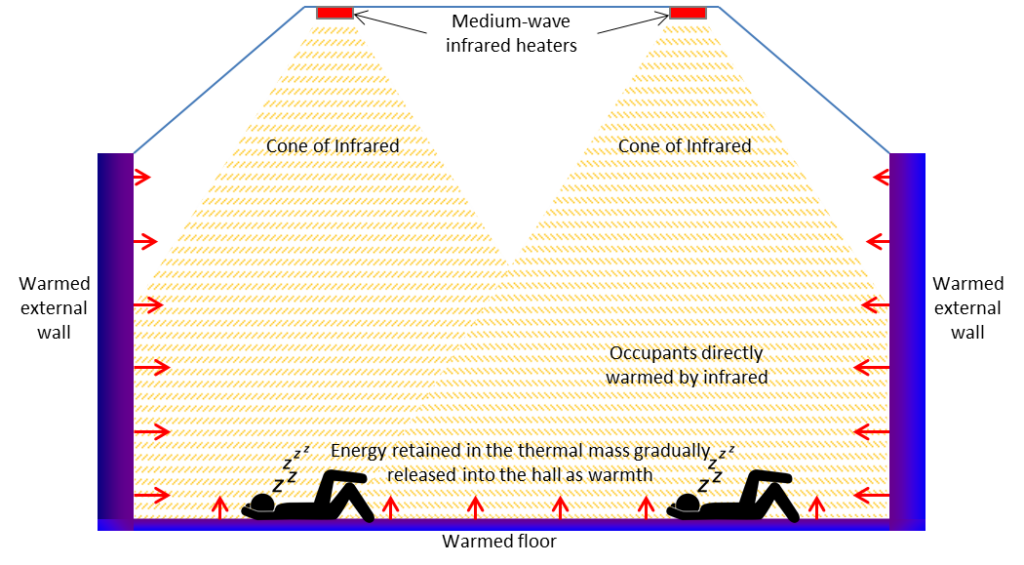Improve energy efficiency
By improved yoga studio insulation, you can reduce heat losses and increases energy savings. Bear in mind that there are other methods of reducing heating costs.
Use the yoga studio as a thermal store
Infrared heaters produce an electromagnetic wave that energises and warms thermal mass directly, for example a building’s structure. The infrared rays are mainly absorbed by the building’s walls and floor. In turn, they serve as a storage medium and gradually release heat back into the room.
The energy produced by an infrared heater is retained within the thermal mass of a building for a significantly longer period than the heat produced by a convection heater. Air is a very poor thermal store! Retaining energy within the building for longer means that less energy is required to maintain the ambient temperature.

Reduce temperature gradient
Warm air is lighter than cold air and it is gathered in the highest spot inside a building. Vertical temperature differences between floor and ceiling occur. The temperature difference between the dwelling zone and the ceiling can be between 5 to 8°C. Equalizing the temperature differences can reduce heat losses by as much as 20% while making optimal use of the heat.
A yoga studio with high ceilings using infrared heating reduces the vertical temperature gradient between floor and ceiling. The heat develops when the rays meet surfaces such as floors and walls. The surfaces in turn heat the air in the dwelling zone. The temperature differences between the ceiling and the floor become very small and overheating is minimal.

The temperature gradient (temperature rise per metre of height) is very low for infrared heaters: approximately 0.3°C/m. In contrast, warm air heating or heating with conventional radiators causes significantly greater temperature differences per metre of height with temperature gradients of 2.5 and 1.7 °C/m respectively.
Lower indoor temperature
Because of the direct heating effect of infrared heaters, the air temperature in a room can be lowered by a few degrees (from 21°C to 18°C) without sacrificing comfort. For every degree the room temperature is lowered, an energy saving of around 6% is realised.
Heat loss in yoga studios
Energy losses in a yoga studio can be divided into two categories:
- Transmission losses via building structures (roof, walls, etc.)
- Ventilation losses through ventilation, leakage and openings

The size of transmission losses varies according to the areas of the building parts and insulation. The losses are proportional to the temperature differences between indoor and outdoor air.
Ventilation losses in a yoga studio are either mechanical or natural / involuntary. Mechanical ventilation usually consists of a supply and exhaust air unit that makes heat reclamation possible. Natural and involuntary ventilation consists of thermal currents causing warm air to rise and leak through openings and unsealed areas.
Types of yoga studio heating system
Within a yoga studio with high ceilings, the heating system must cover all of the energy losses, both from transmission and ventilation. Three main types of heating are used in the UK:
- Infrared heating – transfers heat to surfaces and objects without warming the air on the way. Surfaces are heated and then in turn heat the air within the room. People experience the direct effect of infrared heat as warmth. The room feels comfortably heated, even if the air temperature is relatively low. Infrared heating also prevents overheated air gathering under the ceiling. The minimal temperature gradient between floor and ceiling, as well as the lower air temperature, contributes to large energy savings. Infrared heat effectively counteracts cold radiation and cold draughts, for example from large windows and ill-fitting doors.
- Air heating – uses warm air to cover heat losses from the building. The warm air cools along the outer walls, due to transmission losses. Therefore, the supply air temperature must be higher than the desired room temperature. As the heated air is lighter and rises in the room, large temperature differences occur between the ceiling and the floor. This can mean that it may be necessary to equalise the differences with ceiling fans.
- Convective heating – transfers heat to the room by warming the air as it passes the hot surface of a radiator or convector. The air-flow past the radiator or convector is maintained by convection currents. The warmed air rises and is constantly replaced by cooler air. For example, cold draughts from windows are counteracted by rising warm air if the heat source is placed under the window.
If you would like to find out more, please visit our Contact page.

